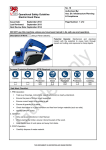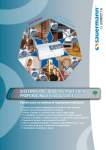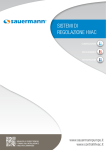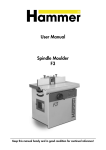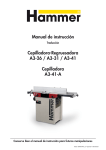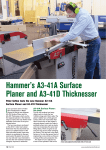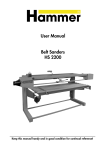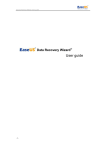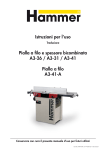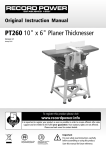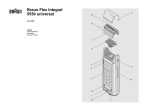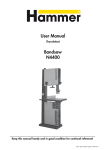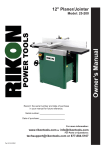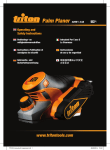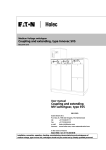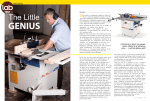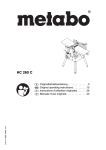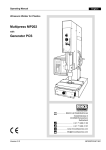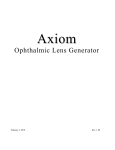Download User Manual Planer-Thicknesser A3-26 / A3-31 / A3-41
Transcript
User Manual Translation Planer-Thicknesser A3-26 / A3-31 / A3-41 Keep this manual handy and in good condition for continual reference Dok.ID: 504010-901_02 • Englisch • 2011-02-09 Planer-Thicknesser A3-26 / A3-31 / A3-41 Note: Year of construction The machine number of this machine will be printed on this operating manual The final two digits of the machine number show the year of construction of this machine e.g. XXX.XX.XXX.10 -> Year of manufacture 2010 Attention! The machine must be inspected immediately upon arrival. If the machine has been damaged during transport, or if any parts are missing, a written record of the problems must be submitted to the forwarding agent and a damage report compiled. Also be sure to notify your supplier immediately. For the safety of all personnel, it is necessary to conscientiously study this manual before assembly and operation. This manual must be kept in good condition, and should be considered as part of the machine. Furthermore, the manual must be kept to hand and within the vicinity of the machine so that it is accessible to operators when using, maintaining or repairing the machine. HAMMER A product of the FELDER GROUP © Felder KG KR-FELDER-STR.1 A-6060 Hall in Tirol Tel.: +43 (0) 5223 / 45 0 90 Fax.: +43 (0) 5223 / 45 0 99 E-Mail: [email protected] Internet: www.hammer.at 2 Planer-Thicknesser A3-26 / A3-31 / A3-41 Table of contents Table of contents 1 General . ........................................................................................................ 6 1.1 Symbol legend................................................................................................................6 1.2 Information about the manual...........................................................................................6 1.3 Liability and warranty......................................................................................................7 1.4 Copyright.......................................................................................................................7 1.5 Warranty notice..............................................................................................................7 1.6 Spare parts....................................................................................................................7 1.7 Disposal.........................................................................................................................8 2 Safety............................................................................................................. 9 2.1 Intended use...................................................................................................................9 2.2 Manual contents.............................................................................................................9 2.3 Making changes and modifications to the machine.............................................................9 2.4 Responsibilities of the operator........................................................................................10 2.5 Personnel requirements...................................................................................................10 2.6 Work safety.................................................................................................................10 2.7 Personal protective equipment.........................................................................................11 2.8 Machine hazards..........................................................................................................11 2.9 Other risks...................................................................................................................12 3 Declaration of Conformity.............................................................................. 13 4 Technical specifications................................................................................... 14 4.1 Dimensions and weight..................................................................................................14 4.2 Electrical connection......................................................................................................14 4.3 Drive motor..................................................................................................................15 4.4 Chip extraction.............................................................................................................15 4.5 Operation and storage conditions...................................................................................15 4.6 Particle emission...........................................................................................................15 4.7 Noise emission.............................................................................................................16 4.7.1 Surface planing.......................................................................................................16 4.7.2 Thickness planing.....................................................................................................16 4.8 Cutterblock...................................................................................................................17 4.9 Planer unit....................................................................................................................17 4.10 Thicknesser unit...........................................................................................................17 4.11 Drilling unit................................................................................................................17 5 Assembly...................................................................................................... 18 5.1 Overview.....................................................................................................................18 5.2 Accessories..................................................................................................................19 5.3 Data plate....................................................................................................................21 5.4 Safety devices..............................................................................................................22 5.4.1 Safety break switches...............................................................................................22 5.4.2 Bridge guard...........................................................................................................22 5.4.3 Rear cutterblock cover...............................................................................................23 5.4.4 Kickback guards......................................................................................................23 5.4.5 Drilling chuck guard.................................................................................................23 5.5 Operation and display elements.....................................................................................24 3 Planer-Thicknesser A3-26 / A3-31 / A3-41 Table of contents 6 Transport, packaging and storage.................................................................. 25 6.1 Safety instructions.........................................................................................................25 6.2 Transport......................................................................................................................25 6.3 Transport inspection.......................................................................................................27 6.4 Packaging....................................................................................................................27 6.5 Storage........................................................................................................................27 7 Setup and installation.................................................................................... 28 7.1 Safety instructions.........................................................................................................28 7.2 Setup...........................................................................................................................28 7.3 Chip extraction.............................................................................................................30 7.4 Electrical connection......................................................................................................31 7.4.1 Alternating-current motor...........................................................................................31 7.4.2 Three-phase alternating current motor.........................................................................31 8 Making adjustments and preparations............................................................ 32 8.1 Safety instructions.........................................................................................................32 8.2 Adjusting the depth of cut...............................................................................................32 8.3 Adjusting the joint.........................................................................................................33 8.4 Adjusting the planer fence..............................................................................................34 8.4.1 Adjusting the angle..................................................................................................34 8.4.2 Sliding....................................................................................................................34 8.5 Adjust the thicknessing height.........................................................................................35 8.6 Adjusting the drilling support..........................................................................................36 8.7 Retooling from a planer to a thicknesser...........................................................................37 8.8 Retooling from a thicknesser to a planer...........................................................................38 8.9 Retooling to the drilling unit............................................................................................39 8.9.1 Mounting the mortising support..................................................................................39 8.9.2 Clamp the drilling tool..............................................................................................39 8.10 Retooling from a drilling operation to a planer or a thicknesser operation...........................40 9 Operation..................................................................................................... 41 9.1 Safety instructions.........................................................................................................41 9.2 Switching on the machine..............................................................................................42 9.3 Switching off the machine / EMERGENCY-STOP...............................................................42 9.4 Surface planing............................................................................................................43 9.4.1 Working position ....................................................................................................43 9.4.2 Workpiece dimensions.............................................................................................43 9.4.3 Authorised and prohibited work techniques.................................................................43 9.4.4 Surface planing - Workpieces up to 75 mm thick.........................................................44 9.4.5 Surface planing - Workpieces over 75 mm thick...........................................................45 9.4.6 Jointing...................................................................................................................46 9.4.7 Bevelling/Chamfering...............................................................................................47 9.4.8 Tapering/beveling small workpieces...........................................................................48 9.5 Thickness planing..........................................................................................................48 9.5.1 Workpiece dimensions.............................................................................................48 9.5.2 Authorised and prohibited work techniques.................................................................48 9.5.3 Work place/work position........................................................................................49 4 Planer-Thicknesser A3-26 / A3-31 / A3-41 Table of contents 9.6 Drilling........................................................................................................................50 9.6.1 Work place/work position........................................................................................50 9.6.2 Workpiece dimensions.............................................................................................50 9.6.3 Authorised and prohibited work techniques.................................................................50 9.6.4 Drilling with/without a depth fence............................................................................51 9.6.5 Mortising................................................................................................................51 10 Service........................................................................................................ 52 10.1 Safety instructions.......................................................................................................52 10.2 Maintenance schedule.................................................................................................52 10.3 Maintenance work......................................................................................................53 10.3.1 Checking/cleaning the kickback guards...................................................................53 10.3.2 Cleaning the feed rollers.........................................................................................53 10.3.3 Greasing the height spindle (thicknesser planing table)...............................................54 10.3.4 Retensioning the drive belt.......................................................................................54 10.3.5 Replacing the drive belt..........................................................................................55 10.3.6 Checking/greasing the chain (transmission)...............................................................56 10.3.7 Checking/changing the friction wheel (transmission)...................................................56 10.3.8 Greasing the height spindle (drilling support).............................................................57 10.3.9 Cleaning the guides (drilling support).......................................................................57 11 Faults.......................................................................................................... 58 11.1 Safety instructions.......................................................................................................58 11.2 What to do if a fault develops......................................................................................58 11.3 What to do after rectifying the fault...............................................................................58 11.4 Faults, causes and repairs............................................................................................59 11.5 Resharpen or replace the planer knife............................................................................60 11.5.1 Reversing/replacing the system planer blades............................................................61 11.5.2 Sharpening/changing the standard planer knives......................................................62 11.6 Correcting the angle of the planing fence.......................................................................63 12 Index.......................................................................................................... 66 5 Planer-Thicknesser A3-26 / A3-31 / A3-41 General 1 General 1.1 Symbol legend Important technical safety instructions in this manual are marked with symbols. These instructions for work safety must be followed. In all these particular cases, special attention must be paid in order to avoid accidents, injury to persons or material damage. Warning! Risk of injury or death This symbol marks instructions that must be followed in order to avoid harm to one›s health, injuries, permanent impairment or death. Attention! Risk of material damage! This symbol marks instructions which, if not observed, may lead to material damage, functional failures and/or machine breakdown. Warning! Danger! Electric current! This symbol warns of potentially dangerous situations related to electric current. Not observing the safety instructions increases the risk of serious injury or death. All electrical repairs must be carried out by a qualified electrician. Note: This symbol marks tips and information which should be observed to ensure efficient and failure-free operation of the machine. 1.2 Information about the manual This manual describes how to operate the machine properly and safely. Be sure to follow the safety tips and instructions stated here as well as any local accident prevention regulations and general safety regulations. Before beginning any work on the machine, ensure that the manual, in particular the chapter entitled “Safety” and the respective safety guidelines, has been read in its 6 entirety and fully understood. This manual is an integral part of the machine and must therefore be kept in the direct vicinity of the machine and be accessible at all times. If the machine is sold, rented, lent or otherwise transferred to another party, the manual must accompany the machine. Planer-Thicknesser A3-26 / A3-31 / A3-41 General 1.3 Liability and warranty The contents and instructions in this manual were compiled in consideration of current regulations and state-of-the-art technology as well as based on our knowhow and experience acquired over many years. This manual must be read carefully before commencing any work on or with this machine. The manufacturer shall not be liable for damage and or faults resulting from the disregard of instructions in the manual. The texts and images do not necessarily represent the delivery contents. The images and graphics are not depicted on a 1:1 scale. The actual delivery contents are dependent on custom-build specifications, add-on options or recent technical modifications and may therefore deviate from the descriptions, instructions and images contained in the manual. Should any questions arise, please contact the manufacturer. We reserve the right to make technical modifications to the product in order to further improve user-friendliness and develop its functionality. 1.4 Copyright This manual should be handled confidentially. It is designated solely for those persons who work on or with the machine. All descriptions, texts, drawings, photos and other depictions are protected by copyright and other commercial laws. Illegal use of the materials is punishable by law. This manual, in its entirety or parts thereof, may not be transferred to third parties or copied in any way or form, and its contents may not be used or otherwise communicated without the express written consent of the manufacturer. Infringement of these rights may lead to a demand for compensation or other applicable claims. We reserve all rights in exercising commercial protection laws. 1.5 Warranty notice A separate warranty notice, which conforms to the specific regulations of the respective country, is enclosed. 1.6 Spare parts Attention! Risk of material damage! Non genuine, counterfeit or faulty spare parts may result in damage, cause malfunction or complete breakdown of the machine. If unauthorised spare parts are fitted into the machine, all warranty, service, compensation and liability claims against the manufacturer and their contractors, dealers and representatives shall be rejected. Use only genuine spare parts supplied by the manufacturer. Note: The original spare parts that have been authorised for use are listed in a separate spare parts catalogue, enclosed in the documentation package supplied with the machine. 7 Planer-Thicknesser A3-26 / A3-31 / A3-41 General 1.7 Disposal If the machine is to be disposed of, separate the components into the various materials groups in order to allow them to be reused or selectively disposed of. The whole structure is made of steel and can therefore be dismantled without difficulties. This material is also easy to dispose of and does not pollute the environment or jeopardise public health. Always comply with international environmental regulations and local disposal laws. Attention! Used electrical materials, electronic components, lubricants and other auxiliary substances must be treated as hazardous waste and may only be disposed of by specialised, licensed firms. 8 Planer-Thicknesser A3-26 / A3-31 / A3-41 Safety 2 Safety At the time of its development and production, the machine was built in accordance with prevailing technological regulations and therefore conforms to industry safety standards. However, hazards may arise should the machine be operated by untrained personnel, used improperly or employed for purposes other than those it was designed for. The chapter entitled “Safety” offers an overview of all the important safety considerations necessary to optimise safety and ensure the safe and trouble-free operation of the machine. To further minimise risks, the other chapters of this manual contain specific safety instructions, all marked with symbols. Besides the various instructions, there are a number of pictograms, signs and labels affixed to the machine that must also be heeded. These must be kept visible and must not be removed. 2.1 Intended use The planer-thicknesser HAMMER A3-26, A3-31, A3-41 has been designed solely for surface planing, thickness planing and mortising wood and similarly machinable materials. Machining materials other than wood is only permitted with the express written consent of the manufacturer. Operational safety is guaranteed only when the machine is used for the intended purposes. Attention! Any use outside of the machine‘s intended purpose shall be considered improper and is therefore not permitted. All claims regarding damage resulting from improper use that are made against the manufacturer and its authorised representatives shall be rejected. The operator shall be solely liable for any damage that results from improper use of the machine. The term “proper use” also refers to correctly observing the operating conditions as well as the specifications and instructions in this manual. The machine may only be operated with original manufacturer parts and accessories. 2.2 Manual contents All those appointed to work on or with the machine must have fully read and understood the manual before commencing any work. This requirement must be met even if the appointed person is familiar with the operation of such a machine or a similar one, or has been trained by the manufacturer. Knowledge about the contents of this manual is a prerequisite for protecting personnel from hazards and avoiding mistakes so that the machine may be operated in a safe and trouble free manner. It is recommended that the operator requests proof from the personnel that the contents of the manual have been read and understood. 2.3 Making changes and modifications to the machine In order to minimise risks and to ensure optimal performance, it is strictly prohibited to alter, retrofit or modify the machine in any way without the express consent of the manufacturer. All the pictograms, signs and labels affixed to the machine must be kept visible, readable and may not be removed. Pictograms, signs and labels that have become damaged or unreadable must be replaced promptly. 9 Planer-Thicknesser A3-26 / A3-31 / A3-41 Safety 2.4 Responsibilities of the operator This manual must be kept in the immediate vicinity of the machine and be accessible at all times to all persons working on or with the machine. The machine may only be operated if it is in proper working order and in safe condition. The general condition of the machine must be controlled and the machine must be inspected for visible defects every time before it is switched on. All instructions in this manual must be strictly followed without reservation. Further to the safety advice and instructions stated in this manual, it is necessary to consider and observe local accident prevention regulations, general safety regulations and current environmental stipulations that apply to the operational range of the machine. The operator and designated personnel are responsible for the trouble-free operation of the machine as well as for clearly establishing who is in charge of installing, servicing, maintaining and cleaning the machine. Machines, tools and accessories must be kept out of the reach of children. 2.5 Personnel requirements Only authorised and trained personnel may work on and with the machine. Personnel must be briefed about all functions and potential dangers of the machine. “Specialist staff“ is a term that refers to those who – due to their professional training, know-how, experience, and knowledge of relevant regulations – are in a position to assess delegated tasks and recognise potential risks. If the personnel lack the necessary knowledge for working on or with the machine, they must first be trained. Responsibility for working with the machine (installation, service, maintenance, overhaul) must be clearly defined and strictly observed. Only those persons who can be expected to carry out their work reliably may be given permission to work on or with the machine. Personnel must refrain from working in ways that could harm others, the environment or the machine itself. It is absolutely forbidden for anyone who is under the influence of drugs, alcohol or reaction-impairing medication to work on or with the machine. When appointing personnel to work on the machine, it is necessary to observe all local regulations regarding age and professional status. The user is also responsible for ensuring that unauthorised persons remain at a safe distance from the machine. Personnel are obliged to immediately report any irregularities with the machine that might compromise safety to the operator. 2.6 Work safety Following the safety advice and instructions given in this manual can prevent bodily injury and material damage while working on and with the machine. Failure to observe these instructions can lead to bodily injury and damage to or destruction of the machine. Disregard of the safety advice and instructions given in this manual 10 as well as the accident prevention regulations and general safety regulations applicable to the operative range of the machine shall release the manufacturer and their authorised representatives from any liability and from all compensation claims. Planer-Thicknesser A3-26 / A3-31 / A3-41 Safety 2.7 Personal protective equipment When working on or with the machine, the following must be strictly observed: Persons with long hair who are not wearing a hairnet are not permitted to work on or with the machine! It is prohibited to wear gloves while working on or with the machine! When working on or with the machine, the following must always be worn by personnel: Protective clothes Sturdy, tight-fitting clothing (tear-resistant, no wide sleeves). Protective footwear that protect the feet from heavy falling objects and prevent sliding on slippery floors Hearing protection To protect against loss of hearing 2.8 Machine hazards The machine has undergone a hazard analysis. The design and construction of the machine are based on the results of this analysis and correspond to state-of-the-art technology. The machine is considered operationally safe when used properly. Nevertheless, there are some remaining risks that must be considered. The machine runs with high electrical voltage. Warning! Danger! Electric current: Electrical energy can cause serious bodily injury. Damaged insulation materials or defective individual components can cause a life-threatening electrical shock. • Before carrying out any maintenance, cleaning and repair work, switch off the machine and ensure that it can not be accidentally switched on again. • When carrying out any work on the electrical equipment, ensure that the voltage supply is completely isolated. • Do not remove any safety devices or alter them to prevent them from functioning correctly. 11 Planer-Thicknesser A3-26 / A3-31 / A3-41 Safety 2.9 Other risks Warning! Risk of injury! Even if the safety measures are complied with, there are still certain associated risks that must be considered when working on the machine: • Risk of injury when changing the planer knives • Risk of injury through accidental contact with the rotating cutterblock • Risk of injury due to ejected workpieces • Risk of injury from workpiece kickback. (when surface 12 planing) • Hearing damage as a result of high noise levels • Health impairments due to the inhalation of airborne particles, especially when working with beech and oak wood. Planer-Thicknesser A3-26 / A3-31 / A3-41 Declaration of Conformity 3 Declaration of Conformity EG-Declaration of Conformity according to Machine Guidelines 2006/42/EG We hereby declare that the machine indicated below, which corresponds to the design and construction of the model we placed on the market, conforms with the health and safety requirements as stated by the EC. Manufacturer: Felder KG KR-FELDER-STR.1 A-6060 Hall in Tirol Product designation: Abricht-Dickten-Hobelmaschine Planer-Thicknesser Make: HAMMER Model designation: A3-26 / A3-31 / A3-41 The following EC guidelines were applied: 2006/42/EG 2006/95/EG 2004/108/EG The following harmonised norms were applied: EN 861 The prototype test was carried out by: Fachausschuss Holz Prüf- und Zertifizierungsstelle im BG-Prüfzert Vollmoellerstraße 11 D-70563 Stuttgart NB 0392 Conformity with the EC Machine Guidelines certified by: EG-Design Test Certificate No. HO 101055 This EC Declaration of Conformity is valid only if the CE label has been affixed to the machine. Modifying or altering the machine without the express written agreement of the manufacturer shall render the warranty null and void. The signatory of this statement is the appointed agent for the compilation of the technical information Hall in Tirol, 1.1.2010 Johann Felder, Managing Director FELDER KG KR-FELDER-STR.1 • A-6060 Hall in Tirol 13 Planer-Thicknesser A3-26 / A3-31 / A3-41 Technical specifications 4 Technical specifications 4.1 Dimensions and weight A D B E C Fig. 4-1: Dimensions Machine A3-26 A3-31 A3-41 1255 mm 1535 mm 1933 mm Overall width (B) 740 mm 790 mm 890 mm Working height - Planer tables (C) 850 mm 850 mm 850 mm 1120 mm 1400 mm 1800 mm 260 mm 310 mm 410 mm 195 kg 240 kg 295 kg A3-26 A3-31 A3-41 Length Width *) 1160 mm 1410 mm 1810 mm 540 mm 580 mm 770 mm Height 1090 mm 1090 mm 1090 mm Weight 255 kg 300 kg 355 kg Total length (A) Total planer table length (D) Surface planing width (E) Weight Machine including packaging *) The transport width measures under 800 mm. This makes it possible to transport the machine through doorways. 4.2 Electrical connection Mains voltage 230/400 ±10% V Safeguarding 16 A triggering characteristic 14 C Planer-Thicknesser A3-26 / A3-31 / A3-41 Technical specifications 4.3 Drive motor The actual values can be found on the data plate. Alternating-current motor Three-phase current motor Motor voltage 1x 230 V 3x 400 V Motor frequency 50/60 Hz 50/60 Hz 1,9 kW – 3,0 kW 3,0 kW 3,0 kW 4,0 kW IP 55 IP 55 Motor power A3-26 S6-40 %*) Motor power A3-31 S6-40 %*) Motor power A3-41 S6-40 %*) System of protection *) S6 = 10 minute operation under load and intermittent service; 40% = relative operating factor, i.e. the motor may be run at the nominal capacity for 4 minutes and afterwards must run idle for 6 minutes. 4.4 Chip extraction A3- 26 Extractor port diameter Air speed A3-31 / A3-41 Drilling unit 100 mm 120 mm 120 mm 20 m/s 20 m/s 20 m/s Vacuum, min. 740 Pa 740 Pa 855 Pa Volume flow, min. (at 20 m/s) 565 m³/h 814 m³/h 814 m³/h 4.5 Operation and storage conditions Operating/room temperature +10° to +40° C Storage temperature –10° to +50 °C Attention! Risk of material damage! Only operate the machine in ambient temperatures from +10° to +40° C. If the instructions are not followed, damage may occur during storage. 4.6 Particle emission The machine was tested for particle emissions according to DIN 33893. The Wood Authority ascertained, according to the “Principles for Testing Particle Emissions” (workplace-related particle concentrations) of woodworking machines, that the particle emission values for this machine are notably below the currently valid atmospheric limit of 2.0 mg/m³. This is certified by the blue label “BG Wood Particle Tested”. 15 Planer-Thicknesser A3-26 / A3-31 / A3-41 Technical specifications 4.7 Noise emission The specified values are emission values and therefore do not represent safe workplace values. Even though a relationship exists between particle emission and noise emission levels, an inference cannot be made about whether additional safety measures need to be implemented. Factors which can significantly affect the emission level that presently exists at the workplace include duration of the effect, characteristics of the workspace, and other ambient influences. The permissible workplace values may also differ from country to country. Nevertheless, this information is provided to help the operator better assess hazards and risks. Depending on the location of the machine and other specific conditions, the actual noise emission values may deviate significantly from the specified values. Note: In order to keep noise emission to a minimum, be sure to always use sharpened planer knives. Ear protection must always be worn; however, such protection cannot be considered a substitute for properly sharpened tools. An allowance must be made to compensate for tolerances with the specified emission values K= 4 dB (A). 4.7.1 Surface planing Acoustic power level according to EN ISO 3746 Idle Working 89,3 dB (A) 100,0 dB (A) Emission values at the workplace according to EN ISO 11202 Idle 84,7 dB (A) Working 90,3 dB (A) 4.7.2 Thickness planing Acoustic power level according to EN ISO 3746 Working position 1 (feeder-side) Idle 89,3 dB (A) Working 98,5 dB (A) Emission values at the workplace according to EN ISO 11202 Working position 1 (feeder-side) Idle 75,2 dB (A) Working 89,8 dB (A) Working position 2 (receiver-side) Idle 71,5 dB (A) Working 89,0 dB (A) 16 Planer-Thicknesser A3-26 / A3-31 / A3-41 Technical specifications 4.8 Cutterblock Cutterblock diameter (knife flight)-Ø 72 mm Number of knives 3 Speed 50/60 Hz 5000/6000 min-1 4.9 Planer unit A3-26 A3-31 A3-41 Maximum depth of cut 4 mm 4 mm 4 mm Surface planing width 260 mm 310 mm 410 mm Planer table length 540 mm 628/730 mm 880 mm 1120 mm 1400 mm 1800 mm 150 x 750 mm 150 x 1100 mm 150 x 1100 mm A3-26 A3-31 A3-41 Thicknessing width 254 mm 304 mm 404 mm Thicknesser table length 540 mm 540 mm 600 mm Thicknessing height, min./max. 4/225 mm 4/225 mm 4/225 mm Feeder 6,5 m/min 6,5 m/min 6,5 m/min Total planer table length Length of surface planer fence Planer fence, tiltable from 90° to -45° 4.10 Thicknesser unit Note: The maximum depth of cut is directly related to the following factors: • Panel width Panel intensity • Type of wood (hardwood or softwood • Wood dampness • Feed rate • Planer knives (SS, HS, HW) • The motor power of your machine 4.11 Drilling unit 2-jaw drilling chuck 1–16 mm Mortising table Height adjustment*) Longitudinal adjustment*) Depth adjustment*) 135 mm 200 mm 130 mm *) Measured from the middle of the cutterblock/drilling tool and the front edge of the drilling chuck guard. 17 Planer-Thicknesser A3-26 / A3-31 / A3-41 Assembly 5 Assembly 5.1 Overview & $ % / ( # " ) ! Fig. 5-1: Overview !Housing with drive motor and gearbox "Thicknesser unit #Vacuum hood with vacuum connector $Bridge guard %Planer table, receiver-side &Combination fence (with rear cover for the cutterblock) /Planer table, feeder-side (Cutterblock with thread for mortising chuck )Switching point 18 Planer-Thicknesser A3-26 / A3-31 / A3-41 Assembly 5.2 Accessories System handwheel Art. No. 12.1.311 " ! 1 Digital clock Art. No. 01.1.202 (Display in “mm”) Art. No. 01.2.202 (Display in “inch”) 2mm/2˚ The digital display is built into both the thicknessing height adjustment system handwheel and the drilling height adjustment system handwheel (drilling support is an add-on option). Exact adjustments to one tenth of a millimeter are possible with the digital display (See assembly instructions „Digital clock“) !Digital clock "System handwheel Fig. 5-2: Digital clock 2-jaw drilling chuck Art. No. 500-118 " The drilling chuck is mounted onto the cutterblock. The mortising chuck holds the mortising tools (See assembly instructions „Drilling chuck and coupler unit“) ! !2-jaw drilling chuck "Cutterblock Fig. 5-3: 2-jaw drilling chuck ! Mortising table / Coupler unit Art. No. 501-117 The coupler unit is mounted onto the machine frame. Hang the mortising support into the coupling device and secure it (See assembly instructions „Drilling chuck and coupler unit“ and „Mortising table“) !Mortising table Fig. 5-4: Drilling chuck and coupler unit 19 Planer-Thicknesser A3-26 / A3-31 / A3-41 Assembly Rolling carriage Art. No. 503-134 Mount the rolling carriage onto the machine housing. The rolling carriage facilitates the task of positioning the machine (See assembly instructions „Rolling carriage“) Fig. 5-5: Rolling carriage Lifting bar Art. No. 500-149 Hook the lifting bar under the rolling carriage coupling (Accessory). The lifting bar and the rolling carriage facilitate the task of maneouvring the machine in the most confined space. (See assembly instructions „Lifting bar“) Fig. 5-6: Lifting bar HAMMER Mounting rail for table extension Art. No. 500-157 (260 mm) Art. No. 500-102 (310 mm) Art. No. 500-151 (410 mm) ! Table extension 500-101 (400x150 mm) 500-151 (800x150 mm) " Fig. 5-7: Table extension 20 Mount the table extension onto the planer tables. The table extension is a safe support for longer workpieces The table can be extended by 400 or 800 mm (See assembly instructions „Table extension“) !Table extension "Mounting Rail for Table Extension Planer-Thicknesser A3-26 / A3-31 / A3-41 Assembly 5.3 Data plate The data plate is found on the back of the machine. !Data plate ! Fig. 5-8: Layout of the data plate KR-FELDER-STR.1 A - 6060 HALL in Tirol AUSTRIA Tel.: 0043 (0)5223 / 45 0 90 Tax.: 0043 (0)5223 / 45 0 99 [email protected] / www.hammer.at TYPE : NR. : V: KW: PH: HZ: A: Baujahr / year of constr. / annee de constr. : Motordaten: The data plate displays the following specifications: • Model designation • Machine number • Voltage • Phases • Frequency • Power • Power supply • Year of construction • Manufacturer information Fig. 5-9: Data plate 21 Planer-Thicknesser A3-26 / A3-31 / A3-41 Assembly 5.4 Safety devices 5.4.1 Safety break switches The cutter block will only run when the safety switch is deactivated by the planer tables or extraction hood. !Break switch for the planer tables ! Fig. 5-10: Safety break switches 5.4.2 Bridge guard ! " # $ The bridge guard covers the cutterblock when surface planing. !Setscrew (Height adjustment) "Bridge guard arm #Protective rail $Clamping screw (Width adjustment) Fig. 5-11: Bridge guard 22 Note: Instructions to adjust the bridge guard are given in the respective working techniques descriptions. Planer-Thicknesser A3-26 / A3-31 / A3-41 Assembly 5.4.3 Rear cutterblock cover ! " # When surface planing, the rear cutterblock cover screens the part of the cutterblock that remains exposed behind the fence. Attach the rear cutterblock cover to the back of the combination fence. The rear cutter block guard is fitted with an additional mount to stabilise the fence. !Planer fence "Cover #Clamping screw Fig. 5-12 Rear cutterblock cover 5.4.4 Kickback guards ! When thicknessing, the kickback guards prevent the workpiece from kicking back. !Kickback guards Fig. 5-13: Kickback guards Note: Only properly adjusted (smoothly operating and sharp) kickback guards will perform this protective function! See Chapter >10.3.1 Checking/cleaning the kickback guards< 5.4.5 Drilling chuck guard The drilling chuck guard covers the 2-jaw drilling chuck on the cutterblock. !Drilling chuck guard ! Fig. 5-14: Drilling chuck guard 23 Planer-Thicknesser A3-26 / A3-31 / A3-41 Assembly 5.5 Operation and display elements !Gear lever # • Position O: (pull out) Surface planing, Jointing, Bevelling/Tapering, mortising and idle machine for a longer period of time • Position I: Thickness planing "System handwheel Adjusting the height on the thicknessing unit (Thickness planing height) $ " #Eccentric (Surface planing) % Adjusting the height of the receiver side of the planer table & ! / $Single-hand clamping lever Clamping the outfeed-side of the planer table ( %Green push button Switching on the machine &Red push button Fig. 5-15: Operation and display elements Emergency stop and switching off the machine /Scale (Thickness planing) Specifying the thicknessing height ) (Single-hand clamping lever Clamping the planer table )Scale (Surface planing) BL BM Specifying the chip thickness on the feeder-side of the planer table BLSingle-hand clamping lever BN Clamping the infeed-side of the planer table BMAdjustment handle (Surface planing) Adjusting the height of the feeder-side of the planer table Fig. 5-16: Operation and display elements BNMain switch (if available) • Position 0:Mains voltage off • Position I: Mains voltage on 24 Planer-Thicknesser A3-26 / A3-31 / A3-41 Transport, packaging and storage 6 Transport, packaging and storage 6.1 Safety instructions Warning! Danger! Electric current: There is a risk of injury as a result of falling parts while transporting, loading or unloading the machine. Attention! Risk of material damage! The machine can be damaged or destroyed if it is subjected to improper handling during transport. For this reason the following safety instructions must be observed: • Never lift loads over a person. • Always move the machine with the utmost care and precaution. • Only use suitable lifting accessories and hoisting devices that have a sufficient load-carrying capacity. • Never transport the machine by putting pressure on any of its projecting elements (e.g. the planer tables). • Consider the machine‘s centre of gravity when transporting it (minimise the risk of it tipping over). • Take measures to prevent the machine from slipping sideways. • Ropes, belts or other hoisting devices must be equipped with safety hooks. • Do not use torn or worn ropes. • Do not use knotted ropes or belts. • Ensure that ropes and belts do not lie against sharp edges. • Transport the machine as carefully as possible in order to prevent damage. • Avoid subjecting the machine to shocks. When transporting the machine overseas, ensure that the packaging is airtight and that a desiccant is added to protect the metal parts against corrosion. 6.2 Transport Attention! Risk of material damage! Transport the machine according to the enclosed transport and assembly instructions! Never lift the machine by its planer tables. Ropes, belts and chains may only be fastened to the base of the machine. Unless otherwise agreed, the machine is delivered in a partly dismantled state on a pallet. The machine is dispatched with its joiner tables closed and secured. Fig. 6-1: It is prohibited to lift the machine by its planer tables! 25 Planer-Thicknesser A3-26 / A3-31 / A3-41 Transport, packaging and storage The machine can be transported with a crane, forklift, pallet jack or rolling carriage. When moving the machine with a forklift or pallet jack, bolt the transportation device (option) onto the housing (See assembly instructions „Transport device“). !Transport device M 10 x 55 ! Fig. 6-2: Transport with a pallet jack Warning! Risk of injury! Remove the transportation device immediately after moving the machine. Note: The rolling carriage and the lifting bar (option) facilitate the task of transporting the machine. Mount the rolling carriage onto the machine housing. (See assembly instructions „Rolling carriage“ and „Lifting bar“) !Rolling carriage "Lifting bar " ! Fig. 6-3: Transport with a rolling carriage 26 Planer-Thicknesser A3-26 / A3-31 / A3-41 Transport, packaging and storage 6.3 Transport inspection Upon arrival, inspect the shipment to ensure that it is complete and has not suffered any damage. If any transport damage is visible, do not accept the delivery or only accept it with reservation. Record the scope of the damage on the transport documents/ delivery note. Initiate the complaint process. For all defects that are not discovered upon delivery, be sure to report them as soon as they are recognised as damage claims must be filed within a certain period, as granted by law. 6.4 Packaging If no agreement has been made with the supplier to take back the packaging materials, help to protect the environment by reusing the materials or separating them according to type and size for recycling. Attention! Dispose of the packaging materials in an environmentally friendly way and always in accordance with local waste disposal regulations. If applicable, contract a recycling firm to dispose of the packaging materials. Note: Help preserve the environment! Packaging materials are valuable raw materials and in many cases, they can be used again or expediently reprocessed or recycled. 6.5 Storage Keep items sealed in their packaging until they are assembled/installed and be sure to observe the stacking and storage symbols on the outside of the packaging. Store packed items only under the following conditions • Do not store outdoors. • Store in a dry and dust-free environment. • Do not expose to aggressive substances. • Protect from direct sunlight. • Avoid subjecting the machine to shocks. • Storage temperature: –10° to +50 °C • Maximum humidity 60 % • Avoid extreme temperature fluctuations (condensation build-up) • Apply a coat of oil to all machine parts open to possible rusting (corrosion protection) • When storing for a period longer than 3 months, apply a coat of oil to all machine parts open to rusting (corrosion protection) Regularly check the general condition of all parts and the packaging. If necessary, refresh or re-apply the coat of anti-corrosive agent. • If the machine is to be stored in a damp environment, it must be sealed in airtight packaging and protected against corrosion (desiccant) • If the machine will not be used for a longer period of time, ensure that the gear lever is positioned on the „0“ setting. 27 Planer-Thicknesser A3-26 / A3-31 / A3-41 Setup and installation 7 Setup and installation 7.1 Safety instructions Warning! Risk of injury! Improper assembly and installation can lead to serious physical injury or equipment damage. For this reason, this work may only be carried out by authorised, trained personnel who are familiar with how to operate the machine and in strict observance of all safety instructions. • Ensure that there is sufficient space to work around the machine. It is very hazardous to thickness plane rail-guided workpieces when there is insufficient clearance to neighbouring machines, to walls or to other fixed equipment. • Keep the work area orderly and clean. Components and tools that are not put in their correct place or put away may be the cause of accidents! • Install the safety equipment according to the instructions and check that it functions properly. Warning! Danger! Electric current: Work on electrical fittings may only be carried out by qualified personnel and in strict observance of the safety instructions. Before assembling and installing the machine, check to make sure it is complete and in good condition. Warning! Risk of injury! An incomplete, faulty or damaged machine can lead to serious physical injury or equipment damage. Only assemble and install the machine if the machine and its parts are complete and intact. Attention! Risk of material damage! Only operate the machine in ambient temperatures from +10° to +40° C. If the instructions are not followed, damage may occur during storage. 7.2 Setup Installation site requirements: • Operating/room temperature: +10° to +40° C • Ensure that the work surface is sufficiently stable and has the proper load-bearing capacity • Provide sufficient light at the workstation • Ensure there is sufficient clearance for or from neighbouring workstations X Fig. 7-1: Space requirements 28 In order to maintain and operate the machine properly, it must be set up at least 500 mm away from the wall, parallel to the work direction (measurement X) (Scale „X“) Planer-Thicknesser A3-26 / A3-31 / A3-41 Setup and installation 1. The machine will be transported to the installation location according to the specifications stated in the „Transport“ chapter and in the enclosed transport and assembly instructions 2. If necessary, the machine can be bolted down to the floor with the transport brackets. ! !Transport brackets 3. Remove the oxidation protective layer from all blank machine parts. Fig. 7-2: Floor mounting 4. Assemble the guard rail and bridge guard: - Bridge guard arm: fasten with allen screws on the planer table. - Loosen the clamping screw. - Protective rail: thread into the arm of the bridge guard - Tighten the clamping screw. ! $ # " Fig. 7-3: Bridge guard $ "! 17 mm # !Bridge guard arm "Allen screws #Protective rail $Clamping screw 5. Mount the planer fence • Fasten guide rail to the machine table with screws, turn locks and spacing washers • Adjust the distance: 17 mm (This setting has to be exact.) • Tighten the nuts. !Screws "Spacer washers #Track $Nuts Fig. 7-4: Mount the planer fence 29 Planer-Thicknesser A3-26 / A3-31 / A3-41 Setup and installation 7.3 Chip extraction Attention! The machine has to be connected to a dust extractor. Vacuum hose must be flame-resistant and must conduct electricity! Be sure to use only genuine H AMMER vacuum hoses! In order to hinder the build-up of dust, it is necessary to have a vacuum system with sufficient capacity. Before operating the machine for the first time, inspect it for defects. Requirements for the dust extraction system and hoses: • The extraction capacity has to generate the required low pressure and the required air speed (See technical data) • Connect the dust extraction system to the machine in such a way so as to operate in unison with the machine. • The dust extraction hoses must be electrically conductive and grounded to prevent electrostatic build up. Fig. 7-5: Extractor port diameter 30 Planer-Thicknesser A3-26 / A3-31 / A3-41 Setup and installation 7.4 Electrical connection Warning! Danger! Electric current: Work on electrical fittings may only be carried out by qualified personnel and in strict observance of the safety instructions. Note: It is prohibited to open the switch box on the machine without the express authorization from the HAMMER Service Department. Violating this stipulation shall render the right to make claims under the warranty null and void. • The machine must be earthed with electrical conductors. • The voltage fluctuations in the mains supply may not exceed ±10 %. • The power supply cable must be protected against damage (e.g. armoured conduit) • The power supply cable must be laid in such a way so it does not overbend or chafe and there is no risk of tripping over it. • Safeguarding: triggering characteristic C Three-phase current motor: 20 A, Alternating-current motor: 16 A, • Power supply cable at least Three-phase current motor: 5x 2,5 Alternating-current motor: 3x 2,5 Warning! Danger! Electric current: Before hooking up the machine to the power supply, compare the specifications on the data plate with those of the electrical network. Only hook up the machine if the two sets of data correspond to each other. The electrical outlet must have the appropriate socket (for a three-phase alternating current motor, CEE). 7.4.1 Alternating-current motor The machine‘s power cable is delivered with an open cable end, i.e. without a plug. The operator is responsible for fitting the machine‘s power cable with a suitable plug in accordance with any country’s specific regulations. 7.4.2 Three-phase alternating current motor • Connect the plug to the power supply. • Switch on and let the machine run briefly. • While the motor is running, check its direction of rotation. • Should a change in the direction of rotation be necessary, switch the two phases on the power cable. Fig. 7-6: Direction of rotation 31 Planer-Thicknesser A3-26 / A3-31 / A3-41 Making adjustments and preparations 8 Making adjustments and preparations 8.1 Safety instructions Warning! Risk of injury! Improper adjustment and setup work can lead to serious physical injury or material damage. For this reason, this work may only be carried out by authorised, trained personnel who are familiar with how to operate the machine and in strict observance of all safety instructions. • Before beginning any maintenance work on the machine, switch it off and secure it against accidentally being switched on again. • Before commencing any work with the machine, inspect it to ensure that it is complete and in technically good condition. • Ensure that there is sufficient space to work around the machine. • Keep the work area orderly and clean. Components and tools that are not put in their correct place or put away may be the cause of accidents! • Install the safety equipment according to the instructions and check that it functions properly. Warning! Danger! Electric current: Work on electrical fittings may only be carried out by qualified personnel and in strict observance of the safety instructions. 8.2 Adjusting the depth of cut ! The depth of cut is adjusted with the adjustment wheel on the feeder-side of the planer table " Move the lever until the desired value has been achieved on the scale !Scale "Lever Fig. 8-1: Adjusting the depth of cut 32 Note: The maximum depth of cut is directly related to the following factors: • Panel width Panel intensity • Type of wood (hardwood or softwood • Wood dampness • Feed rate • Planer knives (SS, HS, HW) • The motor power of your machine Planer-Thicknesser A3-26 / A3-31 / A3-41 Making adjustments and preparations 8.3 Adjusting the joint The receiver-side of the planer table is set so that with a workpiece length of 2 m, an open joint of approximately 0.2 to 0.5 mm is produced (standard setting). The position of the outfeed side of the planer table must be adjusted with regards to the flight of the knife to achieve particular requirements (extremely splayed, open or straight joints): • Planer table above circle of cut: extremely open joint • Planer table height at the circle of cut: straight joint • Planer table below circle of cut: extremely splayed joint Attention! Risk of injury! The planer knives are razor sharp. Handle the planer knives with the utmost care. especially when turning the cutterblock by hand. The joint adjustment is carried out on the receiver-side of the planer table: Required tools: Spanner 17 mm / 13 mm " 1. Switch the machine off and ensure that it cannot be switched on again. 2. Loosen the clamping screw. (Spanner 13 mm) 3. Eccentric: turn until the desired height of the planer table is reached (Spanner 17 mm) 4. Tighten the clamping screw. (Spanner 13 mm) 5. Check the adjustment with a gauge ! !Clamping screw "Eccentric Fig. 8-2: Adjusting the joint 10 1m m 10 5 0 10 5 0 5 0 Checking the joint adjustment: 1. Prepare the gauge as shown in the illustration opposite. 2. Set the gauge on the receiver-side of the planer table edge to “0”. 3. Turn the cutterblock manually. 4. The planing knives should move the gauge 2 to 3 mm. (usual setting) 10 5 0 10 5 0 Fig. 8-3: Checking the joint adjustment 33 Planer-Thicknesser A3-26 / A3-31 / A3-41 Making adjustments and preparations 8.4 Adjusting the planer fence 8.4.1 Adjusting the angle 1. Switch off the machine 2. Loosen the clamping lever. 3. Set the angle between 90° and 45° on the scale. 4. Clamp the clamping lever. ! !Scale "Clamping lever " Fig. 8-4: Adjusting the planer fence 8.4.2 Sliding ! ! Fig. 8-5: Move the planer fence 34 Adjusting the settings to the width of the workpiece: 1. Switch off the machine 2. Loosen the thumb screws. 3. Move the combination fence into the desired position. 4. Tighten the thumb screws. !Thumb screws Planer-Thicknesser A3-26 / A3-31 / A3-41 Making adjustments and preparations 8.5 Adjust the thicknessing height The cutting depth is adjusted by means of the thicknessing table: 1. Switch off the machine 2. Measure the thickness of the workpiece. 3. Loosen the clamping lever. 4. Use the system handwheel to set the desired measurement: thickness of the workpiece minus cutting depth 5. Clamp the clamping lever. ! " # !System handwheel "Scale #Clamping lever Fig. 8-6: Adjust the thicknessing height Note: To compensate for the thread clearance, adjust the thicknessing table from bottom to top. Use the digital display (accessory) to adjust the thicknessing height exactly. (See assembly instructions „Digital clock“). Note: The maximum chip thickness per work cycle is 4 mm. When smooth planing, the maximum cutting depth is 1 mm. The maximum depth of cut is directly related to the following factors: • Panel width Panel intensity • Type of wood (hardwood or softwood • Wood dampness • Feed rate • Planer knives (SS, HS, HW) • The motor power of your machine 35 Planer-Thicknesser A3-26 / A3-31 / A3-41 Making adjustments and preparations 8.6 Adjusting the drilling support ! " # $ % • Height adjustment – Infinitely variable with system handwheel • Longitudinal adjustment – With the one-hand lever • Depth adjustment – With the one-hand lever • Mortising depth limit stop – With depth stop • Mortising length limit stop – With the two lateral stops • Stabilising the workpiece on the table – With the rotating clamp !Rotating clamp "Single-hand lever #Longitudinal stops $System handwheel %Depth stop Fig. 8-7: Adjusting the drilling support 36 Note: Use the digital display (accessory) to adjust the drilling height precisely (See assembly instructions „Digital clock“). Planer-Thicknesser A3-26 / A3-31 / A3-41 Making adjustments and preparations 8.7 Retooling from a planer to a thicknesser ! # # 1. Before beginning any maintenance work on the machine, switch it off and secure it against accidentally being switched on again. 2. Push the planer fence right to the front. See Chapter >8.4 Adjusting the planer fence< 3. Loosen and pull out the clamping lever. 4. Open the planer table and ensure that the fall lock engages correctly. !Planer fence "Clamping lever #Planer tables $Safety catch " Fig. 8-8: Open planer table 5. Remove the vacuum hose from the vacuum hood 6. Tilt up the vacuum hood Ensure the extraction hood slots into place correctly 7. Attach the vacuum hood by means of the connector to a suitable vacuum system. See Chapter >7.3 Chip extraction< KLICK %Vacuum hood % $ Fig. 8-9: Tilt up the vacuum hood Note: Safety break switches are breaking the electric circuit. The planer arbor can only run when the joiner tables are closed or the extractor hood is tilted up. 37 Planer-Thicknesser A3-26 / A3-31 / A3-41 Making adjustments and preparations 8.8 Retooling from a thicknesser to a planer 1. Before beginning any maintenance work on the machine, switch it off and secure it against accidentally being switched on again. 2. Loosen the clamping lever. 3. Using the system handwheel, position the thicknessing table at least 200 mm below the cutterblock. 4. Clamp the clamping lever. ! " # !System handwheel "Scale #Clamping lever Fig. 8-10: Thicknesser table 5. Remove the vacuum hose from the vacuum hood 6. Tilt the vacuum hood downwards 7. Release fall lock/tilt the planer table to you. $Vacuum hood %Safety catch $ % Fig. 8-11: Tilt the vacuum hood downwards 8. Press the clamping lever inwards and lock in place. 7. Attach the vacuum hood by means of the connector to a suitable vacuum system. See Chapter >7.3 Chip extraction< &Clamping lever & Fig. 8-12: Planer tables 38 Note: Safety break switches are breaking the electric circuit. The planer arbor can only run when the joiner tables are closed or the extractor hood is tilted up. Planer-Thicknesser A3-26 / A3-31 / A3-41 Making adjustments and preparations 8.9 Retooling to the drilling unit 8.9.1 Mounting the mortising support 1. Prior to starting to work with the machine, switch it off and secure it against being switched on again. 2. If necessary, mount the coupler unit (accessory). If necessary, mount the 2-jaw drilling chuck (accessory). (See assembly instructions „Drilling chuck and coupler unit“) 3. Both planer tables must be tilted up and secured with the fall locks (Position „Thickness planing“) 4. Affix the drilling table: • Depth adjustment in the hindmost position and • Adjust the length in the middle position 5. Hook the mortising table into the seating bolt 6. Attach the drilling support with the nuts. 7. Connect the drilling support by means of the extractor port to a suitable extraction system See Chapter >7.3 Chip extraction< ! " !Seating bolt "Nuts #Vacuum connector # Fig. 8-13: Mounting the mortising support 8.9.2 Clamp the drilling tool " ! 1. Prior to starting to work with the machine, switch it off and secure it against being switched on again. 2. Open the 2-jaw chuck with an 8 mm Allen key. 3. Clamp the authorised drilling tool along the entire length of the chuck See Chapter >9.6 Drilling< 4. Clamp the 2-jaw chuck with an 8 mm Allen key (minimum torque 20 Nm). !Allen key 8 mm "Drilling tool Fig. 8-14: Clamp the drilling tool 39 Planer-Thicknesser A3-26 / A3-31 / A3-41 Making adjustments and preparations 8.10 Retooling from a drilling operation to a planer or a thicknesser operation " 1. Prior to starting to work with the machine, switch it off and secure it against being switched on again. 2. Unchuck the drilling tool: • Open the 2-jaw chuck with an 8 mm Allen key • Remove the drilling tool from the drilling chuck ! !Drilling tool "Allen key 3. Removing the drilling support: • Release the extractor hose from the extraction port • Affix the drilling table: - Depth adjustment in the hindmost position and - Adjust the length in the middle position • Loosen the nuts. • Detach the drilling table 4. If required, change the tooling to surface planing or thickness planing. Fig. 8-15: Unchuck the drilling tool #Nuts $Vacuum connector # $ Fig. 8-16: Removing the drilling support 40 Planer-Thicknesser A3-26 / A3-31 / A3-41 Operation 9 Operation 9.1 Safety instructions Warning! Risk of injury! Improper operation may lead to severe physical injury or material damage. For this reason, this work may only be carried out by authorised, trained personnel who are familiar with how to operate the machine and in strict observance of all safety instructions. Before starting work: • Before commencing any work with the machine, inspect it to ensure that it is complete and in technically good condition. • Ensure that there is sufficient space to work around the machine. • Keep the work area orderly and clean Components and tools that are not put in their correct place or put away may be the cause of accidents! • Properly adjust both planer tables. • Adjust the combination fence to the workpiece width and lock. • Install the bridge guard and rear cutterblock cover as directed and test their function. • Ensure that all the planer knives are sharp (minimises the kickback risk) • Ensure that all clamping screws on the knife holders are securely tightened (minimum tightening torque 15 Nm) • Ensure that the individual kickback guards are free to move and that they fall back into their initial position after having been raised. • Install the dust extraction system according to the instructions and test its function. • Only machine workpieces that can be safely placed on the machine and guided. • Carefully inspect workpieces for foreign matter (nails, screws) which might impair processing. • When planing, additionally support workpieces that are longer than the feeder- and receiver-sides (by using e.g. table extensions, roller supports) • Ensure that the tool turns freely. • Ensure the cutterblock direction of rotation is correct • Keep tools for handling short and narrow workpieces close at hand (e.g.: wooden pushing stick, push block; See HAMMER-Accessory catalogue) • Before switching on the machine, always check to make sure that there are no other persons in the immediate vicinity of the machine When working on or with the machine, the following must always be worn by personnel: • Sturdy, tight-fitting clothing (tear-resistant, no wide sleeves). • Protective footwear – that protect the feet from heavy falling objects and prevent sliding on slippery floors • Hearing protection – To protect against loss of hearing During operation: • Never place your hands on the workpiece over the cutterblock. • When changing to another workpiece or if a malfunction occurs, first switch off the machine and then secure it against being switched on again accidentally • Do not switch off, circumvent or decommission protective and safety devices during operation When working on or with the machine, the following must be strictly observed: • Persons with long hair who are not wearing a hairnet are not permitted to work on or with the machine! • It is prohibited to wear gloves while working on or with the machine! 41 Planer-Thicknesser A3-26 / A3-31 / A3-41 Operation 9.2 Switching on the machine Note: It is only permitted to switch on the machine if, for the work at hand, the required preconditions are fulfilled and any preliminary work is completed. Therefore, the adjusting, fitting and operating instructions (see the corresponding chapters) must be read before switching on the machine. 1. Connect the machine to the main power supply. 2. If available: unlock the main switch and switch on (position “I”). 3. Only with alternating current: • Press the green button on the control panel and hold it pressed down. • Release the push button once the machine has reached the maximum rotational speed. With a three-phase current motor • Press green push button on the control panel and release. " ! !Main switch "Green push button - ON Fig. 9-1: Switching on the machine Attention! Risk of material damage! Improper operation may cause damage to the machine. Do not activate the green push button whilst the machine is in operation! 9.3 Switching off the machine / EMERGENCY-STOP 1. Push and release the red push button. The machine is stopped automatically. 2. If available: switch off the main switch (position “0”) and secure. 3. Disconnect the machine from the main power supply. !Red push button - OFF "Main switch ! " Fig. 9-2: Switching off the machine 42 Planer-Thicknesser A3-26 / A3-31 / A3-41 Operation 9.4 Surface planing Note: Surface planing evens irregular workpiece surfaces. The workpieces are guided over the cutterblock and only their undersides are machined. The direction of cutterblock rotation is opposite to the feed direction of the workpiece. 9.4.1 Working position Take up the position as shown in the opposite picture when working with the machine Fig. 9-3: Work place/work position 9.4.2 Workpiece dimensions Length Width Thickness under 250 mm: only work with special devices (e.g.: wooden pushing stick) over 1500 mm: only work with table extensions or with a second person max. 260 mm / 310 mm / 410 mm (depending on the equipment) min. 10 mm Attention! Risk of injury! If a workpiece is smaller than 10 mm, it may split if the depth of cut is too large (4 mm). The finished planed workpiece must not be thinner than 6 mm! 9.4.3 Authorised and prohibited work techniques Only the following working techniques are permitted with the planer unit: • Planing the wide side of a workpiece • Jointing the narrow side of a workpiece • Bevelling the narrow side of a workpiece • Bevelling the edges of a workpiece The following working techniques are absolutely forbidden with the planer unit: • Down-cut planing (direction of cutterblock rotation is the same as feed direction) • Insertion cuts (the workpiece is not worked over its entire length) • Planing workpieces that are very warped • Rabbet planing at the end of the cutterblock 43 Planer-Thicknesser A3-26 / A3-31 / A3-41 Operation 9.4.4 Surface planing - Workpieces up to 75 mm thick ! # " Fig. 9-4: Bridge guard !Setscrew "Clamping screw #Protective rail 1. Before beginning any maintenance work on the machine, switch it off and secure it against accidentally being switched on again. 2. Both planer tables must be shut and fixed with the clamping levers. 3. Set the gear lever to the “0” setting. 4. Extraction system must be connected 5. Planer fence: set at 90°. 6. Adjusting the depth of cut. 7. Adjust the joint, if necessary. 8. Adjust the bridge guard: • Use the setscrew to fix the guard rail approx. 2 mm over the workpiece. • Place the workpiece against the planer fence and push it slightly under the guard rail (not over the cutterblock!). • Loosen the clamping screw. • Move the guard rail right up to the planer fence. • Tighten the clamping screw. 9. Switch the machine on 10. Take up work position. Fig. 9-5: Guiding the workpiece 11.Machining the workpiece: • Lay your hands flat on the workpiece, ensuring that your fingers are balled into a fist and thumbs are pressed against the workpiece. • Push the workpiece straight over the feeder-side of the planer table. • Then let your hands glide one after the other over the bridge guard. • As soon as it is possible, use both hands to continuously push the workpiece on the receiver-side of the planer table. • The pushing stick must not be thicker than the workpiece after it is cut. 12.If you are not going to continue working, switch off the machine and secure it against being turned on again accidentally Fig. 9-6: Wooden push stick and push block Attention! Risk of injury! When planing smaller workpieces, use a pushing stick or pushing block. 44 Planer-Thicknesser A3-26 / A3-31 / A3-41 Operation 9.4.5 Surface planing - Workpieces over 75 mm thick ! " # Fig. 9-7: Bridge guard !Setscrew "Clamping screw #Protective rail 1. Before beginning any maintenance work on the machine, switch it off and secure it against accidentally being switched on again. 2. Both planer tables must be shut and fixed with the clamping levers. 3. Set the gear lever to the “0” setting. 4. Extraction system must be connected 5. Planer fence: set at 90°. 6. Adjusting the depth of cut. 7. Adjust the joint, if necessary. 8. Adjust the bridge guard • Loosen the clamping screw. • Pull out the guard rail (slightly more than the workpiece width). • Place the workpiece against the planer fence and push it to the front edge of the feeder planer table (not over the cutterblock!). • Bring the guard rail right up to the workpiece • Tighten the clamping screw. • Use the setscrew to lower the guard rail to the planer table. 9. Switch the machine on 10.Take up work position. Fig. 9-8: Guiding the workpiece 11.Machining the workpiece: • Lay your hands flat on the workpiece, ensuring that your fingers are balled into a fist and thumbs are pressed against the workpiece. • Guide the workpiece straight along the fence over the feeder-side of the planer table. • As soon as it is possible, use both hands to continuously push the workpiece on the receiver-side of the planer table. • The pushing stick should not be thicker than the workpiece. 12.If you are not going to continue working, switch off the machine and secure it against being turned on again accidentally Fig. 9-9: Wooden push stick and push block Attention! Risk of injury! When planing smaller workpieces, use a pushing stick or pushing block. 45 Planer-Thicknesser A3-26 / A3-31 / A3-41 Operation 9.4.6 Jointing Note: To obtain exact joints, use only evenly grown wood without any knots. ! " # Fig. 9-10: Bridge guard !Setscrew "Clamping screw #Protective rail 1. Before beginning any maintenance work on the machine, switch it off and secure it against accidentally being switched on again. 2. Both planer tables must be shut and fixed with the clamping levers. 3. Set the gear lever to the “0” setting. 4. Extraction system must be connected 5. Planer fence: set at 90°. 6. Adjusting the depth of cut. 7. Adjust the joint, if necessary. 8. Adjust the bridge guard • Loosen the clamping screw. • Pull out the guard rail. (somewhat more than the width of the workpiece). • Place the workpiece against the planer fence and push it to the front edge of the feeder planer table (not over the cutterblock). • Bring the guard rail right up to the workpiece • Tighten the clamping screw. • Use the setscrew to lower the guard rail to the planer table. 9. Switch the machine on 10.Take up work position. Fig. 9-11: Guiding a workpiece 11.Machining the workpiece: • With your left hand (balled into a fist and the thumbs placed onto the workpiece), press the workpiece against the combination fence and the receiver-side of the planer table. • With your right hand (balled into a fist and the thumbs placed onto the workpiece), push the workpiece smoothly over the cutterblock • The pushing stick should not be thicker than the workpiece. 12.If you are not going to continue working, switch off the machine and secure it against being turned on again accidentally Fig. 9-12: Wooden push stick and push block Attention! Risk of injury! When jointing smaller workpieces, use a pushing stick or pushing block. 46 Planer-Thicknesser A3-26 / A3-31 / A3-41 Operation 9.4.7 Bevelling/Chamfering Note: With this procedure, the edges of a workpiece can be bevelled or tapered to any desired angle (max. –45°). 1. Before beginning any maintenance work on the machine, switch it off and secure it against accidentally being switched on again. 2. Both planer tables must be shut and fixed with the clamping levers. 3. Set the gear lever to the “0” setting. 4. Extraction system must be connected 5. Planer fence: Adjusting the angle 6. Adjusting the depth of cut. 7. Adjust the joint, if necessary. ! " # Fig. 9-13: Bridge guard !Setscrew "Clamping screw #Protective rail 10 mm 10 mm Fig. 9-14: Bridge guard 10 mm 10 mm 8. Adjust the bridge guard: • Loosen the clamping screw. • Pull out the guard rail. (somewhat more than the width of the workpiece). • Place the workpiece against the planer fence and push it to the front edge of the feeder planer table (not over the cutterblock). • Bring the guard rail up to 10 mm of the workpiece. • Tighten the clamping screw. • Use the setscrew to fix the guard rail 10 mm over the planer tables. 9. Switch the machine on 10.Take up work position. 11.Machining the workpiece: • To avoid the workpiece sliding down the inclined surface, using the left hand, press the workpiece mainly against the planer fence and only slightly against the feeder side of the planer table. • With your right hand (balled into a fist and the thumbs placed onto the workpiece), push the workpiece smoothly over the cutterblock 12.If you are not going to continue working, switch off the machine and secure it against being turned on again accidentally Fig. 9-15: Guiding a workpiece 47 Planer-Thicknesser A3-26 / A3-31 / A3-41 Operation 9.4.8 Tapering/beveling small workpieces See Chapter: >9.4.7 Bevelling/Tapering< • When bevelling or tapering small, narrow workpieces, always use a special power feeder. • The power feeder is mounted onto the planer fence. • Set the bridge guard all the way down and let the protective bridge rest against the power feeder. Fig. 9-16: Jig Attention! Risk of injury! When bevelling or tapering small, narrow workpieces, always use a special power feeder. 9.5 Thickness planing Note: Workpieces that already have a planed surface can be made thinner by being thicknessed. The workpieces are guided through the planer. The workpiece lies with its planed surface on the thicknessing table, and only the upper side is machined. 9.5.1 Workpiece dimensions Width Thickness max. 206 mm / 306 mm / 406 mm (depending on the equipment) min. 4 mm max. 250 mm 9.5.2 Authorised and prohibited work techniques Only the following working technique is permitted on the thicknessing unit: • A maximum of 2 workpieces can be thickness-planed simultaneously. It is absolutely forbidden to perform the following working technique on the thicknessing unit: • Thicknessing several workpieces of varying thicknesses Attention! Risk of material damage! When working on 2 workpieces simultaneously, their thickness may not differ by more than 1 mm. 48 Planer-Thicknesser A3-26 / A3-31 / A3-41 Operation 9.5.3 Work place/work position When working, adopt the working position displayed in the diagram opposite. 1. Before beginning any maintenance work on the machine, switch it off and secure it against accidentally being switched on again. 2. If required, retool from surface planing to thickness planing. 3. Extraction system must be connected 4. Every time the machine is put into operation, test the kickback guards to ensure that they are functioning properly. 5. Adjust the thicknessing height. Use the system handwheel to set the desired measurement. Clamp the clamping lever. Fig. 9-17: Working position 6. Switch the machine on 7. Lift and then release the gear lever 8. Take up work position. 9. Machining the workpiece: • Push the workpiece into the machine until it is pulled in by the feed rollers. • When the workpiece exits on the other side, support it so it does not tip down " ! Fig. 9-18: Working a single workpiece 10.If you are not going to continue working, switch off the machine and secure it against being turned on again accidentally 11.Set the gear lever to the “0” setting. !Clamping lever "Gear lever Fig. 9-19: Working two workpieces Note: For easy handling, use the table extensions (See assembly instructions „Table extension“). Note: A maximum of 2 workpieces may be worked simultaneously. The thickness of the workpieces may not differ by more than 1 mm. The workpieces must each be inserted at the end of the feed roller. 49 Planer-Thicknesser A3-26 / A3-31 / A3-41 Operation 9.6 Drilling Note: A workpiece lying on the mortising table is held in place by an eccentric clamp and can only be machined on the front side. Attention! Risk of injury! The drill bit can bore all the way through the workpiece. Do not place your hand on the workpiece in the vicinity of the bore. 9.6.1 Work place/work position When working, adopt the working position displayed in the diagram opposite. Use only original HAMMER mortising tools (See Accessory catalogue) Only the following left-hand cutting tools are authorised: Dowel bit Ø 4–6 mm Router bit Ø 4–16 mm Forstner drill Ø 15–35 mm Plug cutters Ø 10–35 mm Fig. 9-20: Work place/work position 9.6.2 Workpiece dimensions Length max. 1500 mm Width max. 200 mm Thickness max. 100 mm 9.6.3 Authorised and prohibited work techniques Only the following working techniques are permitted on the drilling unit: • Drilling holes with or without a depth stop • Removing knots • Creating dowel holes • Producing slots and deep holes 50 It is absolutely forbidden to perform the following working techniques on the drilling unit: • Using abrasive wheels of any kind • Moulding with moulding tools Planer-Thicknesser A3-26 / A3-31 / A3-41 Operation 9.6.4 Drilling with/without a depth fence Fig. 9-21: Drilling a hole 1. Before beginning any maintenance work on the machine, switch it off and secure it against accidentally being switched on again. 2. Retooling to a drilling operation. 3. Set the gear lever to the “0” setting. 4. Extraction system must be connected 5. Clamp the drilling tool. 6. Lay the workpiece against the workpiece stop edge and clamp. 7. Set the desired drilling depth with the depth stop if required. 8. Switch the machine on 9. Take up work position. 10.In addition, support the workpiece with your left hand and drill a hole. 11.If you are not going to continue working, switch off the machine and secure it against being turned on again accidentally 9.6.5 Mortising Fig. 9-22: Mortising 1. Before beginning any maintenance work on the machine, switch it off and secure it against accidentally being switched on again. 2. Retooling to a drilling operation. 3. Set the gear lever to the “0” setting. 4. Extraction system must be connected 5. Clamp the drilling tool. 6. Lay the workpiece against the workpiece stop edge and clamp. 7. Set the desired mortise limit with the longitudinal stops. 8. Switch the machine on 9. Take up work position. 10.In addition, hold the workpiece with the left hand. • Using the mortising tool, dip a few millimeters into the workpiece and trace the limited path. • After that, insert the mortise several millimetres into the workpiece and drive it through the limited path. • Repeat this process until the depth of the mortise is achieved. 11.If you are not going to continue working, switch off the machine and secure it against being turned on again accidentally 51 Planer-Thicknesser A3-26 / A3-31 / A3-41 Service 10 Service 10.1 Safety instructions Warning! Risk of injury! Improper maintenance can cause serious injury or damage. For this reason, this work may only be carried out by authorised, trained personnel who are familiar with how to operate the machine and in strict observance of all safety instructions. • Before beginning any maintenance work on the machine, switch it off and secure it against accidentally being switched on again. • Keep the work area orderly and clean Components and tools that are not put in their correct place or put away may be the cause of accidents! • Ensure that there is sufficient space to work around the machine. • Following the maintenance work, reinstall the guards and check that they are functioning properly. Warning! Danger! Electric current: Work on electrical fittings may only be carried out by qualified personnel and in strict observance of the safety instructions. 10.2 Maintenance schedule Interval Component Task to accomplish Daily Machine Remove dust and shavings Table surfaces Remove dust and shavings Planer fence Remove dust and shavings Dust extractor Check for defects Kickback guards Check if functioning, if necessary remove any resin residue Dust extractor Check efficiency Drive belt Check, if necessary: readjust the tension or replace Feed rollers Remove any resin residue Height spindle (Thicknesser table) Control and lubrication (if required) Height spindle (Mortising table) Control and lubrication (if required) Guides (Mortising table) Clean Chain (Gearbox) Check and lubricate if necessary Friction wheel (Gearbox) Check and exchange if necessary System planer knives Check and if necessary reverse or replace Standard planer knives Check and if necessary, sharpen or replace Monthly OR: approx. Every 40 operating hours Every 6 months Poorly planed surface 52 Note: Cleaning and care products are available as accessories. (See Tools and Accessories catalogue) Planer-Thicknesser A3-26 / A3-31 / A3-41 Service 10.3 Maintenance work 10.3.1 Checking/cleaning the kickback guards 1. Before beginning any maintenance work on the machine, switch it off and secure it against accidentally being switched on again. 2. Check if functioning: the kickback guards must fall back after having been lifted 3. Check if functioning: • Push a planed board into the machine. • Adjust the height of the thicknessing table so that there is 0.5 to 1 mm gap between the board and the cutterblock’s circle of cut. • It should not be possible to pull the board out of the machine. • Push the board out of the machine. 4. Remove any resin residue: Resin Remover Art. No. 10.0.022 (0,5 l) / 10.0.023 (1,0 l) # Fig. 10-1: Kickback guards 0,5 - 1 mm !Planed board "Thicknesser table #Kickback guards $Cutterblock !"#$ Fig. 10-2: Testing the kickback guards Note: Should the kickback guards not function properly even after having been cleaned, please contact the HAMMER Service department. 10.3.2 Cleaning the feed rollers ! 1. Before beginning any maintenance work on the machine, switch it off and secure it against accidentally being switched on again. 2. Remove any resin residue on the feed rollers: Resin Remover Art. No. 10.0.022 (0,5 l) / 10.0.023 (1,0 l) !Feed rollers Fig. 10-3: Cleaning the feed rollers 53 Planer-Thicknesser A3-26 / A3-31 / A3-41 Service 10.3.3 Greasing the height spindle (thicknesser planing table) ! Fig. 10-4: Lubricating the height spindle 1. Before beginning any maintenance work on the machine, switch it off and secure it against accidentally being switched on again. 2. Loosen the clamping lever. 3. Use the system handwheel to move the thicknessing table all the way up 4. Clean the spindles and lubricate with regular machine grease. 5. Use the system handwheel to move the thicknessing table all the way down and then all the way back up again. 6. Clamp the clamping lever. !Thicknesser table height spindle "Lubrication hole #Single-hand clamping lever 10.3.4 Retensioning the drive belt Over time, the drive belt will lose its capacity to transmit power. At this point, the drive belt must be re-tensioned or replaced. ! " The drive belt must be inspected monthly; if tears are discovered, the drive belt must be replaced. 1. Before beginning any maintenance work on the machine, switch it off and secure it against accidentally being switched on again 2. Set the gear lever to the “0” setting. 3. Loosen the nuts. 4. Use the belttensioning screw to tension the drive belt. 5. Tighten the nuts !Tightening screw "Nuts Fig. 10-5: Retensioning the drive belt Attention! Risk of material damage! Do not over-tension the drive belt!. Turn the belt-tensioning screw only until the drive belt is sufficiently tensioned to transmit power effectively. 54 Planer-Thicknesser A3-26 / A3-31 / A3-41 Service 10.3.5 Replacing the drive belt " ! 1. Before beginning any maintenance work on the machine, switch it off and secure it against accidentally being switched on again. 2. Set the gear lever to the “0” setting Remove the thumb nut Dismantle the planer fence 3. Loosen the screw and take off the covering lid. # # " !Thumb nut "Screws #Cover " " Replacing the drive belt: Also see: 10.3.4 Retensioning the drive belt Fig. 10-6: Replacing the drive belt 4. Loosen the nuts. 5. Remove the old drive belt 6. Hook the new drive belt into place: -First hook the belt onto the drive motor (if necessary, open the gearbox cover -Pull up the drive motor with the drive belt -Hook the drive belt onto the cutterblock 7. Use the belt-tensioning screw to tension the drive belt. 8. Tighten the nuts 9. Fit and screw the covering lid back on $ % # #Gearbox cover $Drive belt %Drive motor Fig. 10-7: Retensioning the drive belt Attention! Risk of material damage! Do not over-tension the drive belt!. Turn the belt-tensioning screw only until the drive belt is sufficiently tensioned to transmit power effectively. 55 Planer-Thicknesser A3-26 / A3-31 / A3-41 Service 10.3.6 Checking/greasing the chain (transmission) " ! $ # # " 1. Before beginning any maintenance work on the machine, switch it off and secure it against accidentally being switched on again. 2. Set the gear lever to the “0” setting Remove the thumb nut Dismantle the planer fence 3. Loosen the screw and take off the covering lid. 4. Check the chain and lubricate with regular machine grease if necessary. 5. Fit and screw the covering lid back on !Thumb nut "Screws Cover " # $Chain " Fig. 10-8: Checking/greasing the chain (transmission) 10.3.7 Checking/changing the friction wheel (transmission) Note: The friction wheel is subject to wear. Should the examination reveal a heavily damaged or worn surface, then the friction wheel must be replaced. % $ # 1. Switch the machine off and ensure that it cannot be switched on again. 2. Set the gear lever to the “0” setting. 3. Loosen and remove the hex nuts. Take off the covering lid 4. Unscrew the screw and remove the spring washer. 5. Remove the thrust plate. 6. Replace the friction wheel. 7. Place the thrust plate back on. 8. Screw the spring washer on. 9. reassemble the cover. 5x ! " Fig. 10-9: Friction wheel: check/replace 56 !Nuts / Disk spring "Friction wheel #Screw / Lock washer $Pressure disk %Gearbox cover Planer-Thicknesser A3-26 / A3-31 / A3-41 Service 10.3.8 Greasing the height spindle (drilling support) 1. Before beginning any maintenance work on the machine, switch it off and secure it against accidentally being switched on again. 2. Wipe away old grease residues and remove dust from the spindle. 3. Lubricate the spindle with regular machine grease. 4. Use the system handwheel to move the drilling table all the way up and down. " ! !Spindle "System handwheel Fig. 10-10: Lubricating the height spindle 10.3.9 Cleaning the guides (drilling support) # ! # " # Fig. 10-11: Cleaning the guides 1. Before beginning any maintenance work on the machine, switch it off and secure it against accidentally being switched on again. 2. Use the system handwheel to move the drilling table into the uppermost position 3. Use the one-hand lever to move the mortising table into the front-most position on the left side 4. Clean the guides with a soft cloth. on the reverse side, too 5. Use the one-hand lever to move the mortising table into the hindmost position on the right side 6. Clean the guides with a soft cloth !Single-hand lever "System handwheel #Guides Attention! Do not grease or oil the guides! 57 Planer-Thicknesser A3-26 / A3-31 / A3-41 Faults 11 Faults 11.1 Safety instructions Warning! Risk of injury! Repairing faults incorrectly can result in personal injury or damage to the machine. For this reason, this work may only be carried out by authorised, trained personnel who are familiar with how to operate the machine and in strict observance of all safety instructions. Warning! Danger! Electric current: Work on electrical fittings may only be carried out by qualified personnel and in strict observance of the safety instructions. 11.2 What to do if a fault develops In most cases: 1. In the event of problems which may present a danger to people, objects or operational safety, stop the machine immediately using the red OFF button. 2. Also disconnect the machine from the mains and ensure it can not be switched on again. 3. Inform those responsible for machine faults immediately. 4. Type and extent of fault should be determined by an authorised professional, as well as the cause and repair. 11.3 What to do after rectifying the fault Warning! Risk of injury! Repairing faults incorrectly can result in personal injury or damage to the machine. Before switching the machine back on • The fault and its cause are professionally repaired. • All safety equipment has been assembled according to regulations and is working correctly. • Individuals are not located within the danger area of the machine. 58 Planer-Thicknesser A3-26 / A3-31 / A3-41 Faults 11.4 Faults, causes and repairs Fault Cause Repair Machine does not start Main switch at setting „0“ Check switch position Planer tables and/or vacuum hood incor- Close planer tables properly and position rectly positioned (Safety break switch is the vacuum hood correctly not activated) Squeaking noises when starting up Insufficient tension (Drive belt) Retensioning the drive belt The joint is not true (extremely splayed or open joint) Receiver-side of the planer table is misaligned Planer knives are worn out Adjusting the joint Replace the planer knives*1) Replace the planer knives*1) When surface planing, workpiece stops at the receiver-side of the planer table Receiver-side of the planer table is too high in relation to the circle of cut Adjusting the joint Replace the planer knives*1) „Straight cut“ at the end of the workpiece when surface planing Receiver-side of the planer table is too low in relation to the circle of cut Adjusting the joint Replace the planer knives*1) The planer fence angle is not correct Angle setting misadjusted Correcting the angle of the planing fence Unsatisfactory planing result System planer knife Check and if necessary reverse or replace Standard planer knives Check and if necessary, sharpen or replace „Straight cut“ at the beginning of the workpiece when thickness planing Insufficient spring pressure on the feederside (corrugated) feed roller Adjusting the feed rollers*2) „Straight cut“ at the end of the workpiece when thickness planing Insufficient spring pressure on the extraction-side (smooth) feed roller Adjusting the feed rollers*2) „Oblique cut“ at the beginning Insufficient spring pressure on one side of Adjusting the feed rollers*2) of the workpiece when thickthe feeder-side (corrugated) feed roller ness planing „Oblique cut“ at the end of the Outfeed roller (smooth) spring pressure workpiece when thickness too low on one side planing Adjusting the feed rollers*2) *1) System planer knives Reverse or replace Standard planer knives Sharpen or replace Adjusting the joint *2) Contact service technician 59 Planer-Thicknesser A3-26 / A3-31 / A3-41 Faults 11.5 Resharpen or replace the planer knife Note: Checking the joint adjustment Reverse or replace the planer knives once the planing results are no longer satisfactory. See Chapter >8.3 Adjusting the joint<! Note: Only use original HAMMER planer knives! System planer knives 260 310 410 Cobalt HS – 3 pcs. 500-07-011 500-07-002 500-07-005 Chrome steel (SS) – 3 pcs. 500-07-010 500-07-001 500-07-004 Standard planer knives 260 310 410 Cobalt HS – 1 pcs. 500-07-006 500-07-007 500-07-008 Tungsten carbide (HW) – 1 pcs. 07.4.226 07.4.231 07.4.241 10 5 In the event of poor planing results, turn the planer knives (system knives), sharpened (re-usable knives) or replace. 0 Checking the planer knives: 10 5 0 10 1m m 10 5 0 Fig. 11-1: Planer knife check 60 0 10 5 0 Checking the joint adjustment: It may be necessary to readjust the joint if the planer knives have been changed or replaced. See Chapter >8.3 Adjusting the joint< 10 5 0 10 5 0 5 1. Prepare two gauges according to the illustration opposite. 2. Set the gauges at “0” on the outfeed side of the planer table edge on the left and right ends of the cutterblock. 3. Turn the cutterblock manually. 4. The planer knife should move the gauges 2 to 3 mm (Manufacturer’s settings). 5. Should the setting not be correct: See Chapter >8.3 Adjusting the joint< Planer-Thicknesser A3-26 / A3-31 / A3-41 Faults 11.5.1 Reversing/replacing the system planer blades Attention! Risk of injury! The planer knives are razor sharp. Handle the planer knives with the utmost care. especially when turning the cutterblock by hand. Attention! Execute the following instructions exactly! Always tighten the knife holder screws from the inside to the outside. 2 1 1. Before beginning any maintenance work on the machine, switch it off and secure it against accidentally being switched on again. 2. Both planer tables must be tilted up and secured with the fall locks. 3. Remove all the blade-holder screws from one planer knife. 4. Remove the knife holder and planer knife. 5. Clean resin residues thoroughly from the planer knife, knife base and cutterblock. Use resin remover art. no. 10.0.002 (0.5l) or 10.0.023 (1l). 6. Reverse the planer knife (if only one cutting edge ‘ is worn) 4 3 ! Fig. 11-2: Reversing/replacing the system planer blades ! # " ! 7. Insert the planer knife (reversed or new) and the knife holder again. 8. First, gently tighten all the blade-holder screws. 9. Tighten all the knife holder screws (minimum torque 15 Nm). 10.Repeat steps 3 to 9 for the other planer knives. !Blade-holder screws "Blade holder #Planer knife Fig. 11-3: Assembling position Attention! Risk of material damage! Do not clean with compressed air! Ensure that the planer knife is positioned correctly! Note: Checking the joint adjustment It may be necessary to readjust the joint if the planer knives have been changed or replaced. See Chapter >8.3 Adjusting the joint< 61 Planer-Thicknesser A3-26 / A3-31 / A3-41 Faults 11.5.2 Sharpening/changing the standard planer knives Attention! Risk of injury! The planer knives are razor sharp. Handle the planer knives with the utmost care. especially when turning the cutterblock by hand. Attention! Execute the following instructions exactly! Always tighten the knife holder screws from the inside to the outside. 1 2 1. Before beginning any maintenance work on the machine, switch it off and secure it against accidentally being switched on again. 2. Both planer tables must be tilted up and secured with the fall locks. 3. Remove all the blade-holder screws from one planer knife. 4. Remove the knife holder and planer knife. 5. Clean resin residues thoroughly from the planer knife, knife base and cutterblock. Use resin remover art. no. 10.0.002 (0.5l) or 10.0.023 (1l). 6. Resharpen or replace the planer knife. 4 3 ! Fig. 11-4: Sharpening/changing the standard planer knives ! " ! min 19 mm % min 19 mm # $ Fig. 11-5: Assembling position 7. Insert the planer knife and knife holder again. First, gently tighten all the blade-holder screws. 8. Place the adjustment device onto the cutterblock so that the planer knife points towards the marking. The planer knives are pushed towards the top by the adjustment springs. 9. Tighten all the knife holder screws (minimum torque 15 Nm). 10.Repeat steps 3 to 9 for the other planer knives. !Blade-holder screws "Blade holder #Planer knife $Adjustment spring %Adjustment device &Marking Attention! Risk of material damage! Do not clean with compressed air! Ensure that the planer knife is positioned correctly! 62 Note: Checking the joint adjustment It may be necessary to readjust the joint if the planer knives have been changed or replaced. See Chapter >8.3 Adjusting the joint< Planer-Thicknesser A3-26 / A3-31 / A3-41 Faults 11.6 Correcting the angle of the planing fence " " # ! # Fig. 11-6: Correcting the angle of the combination fence 1. Before beginning any maintenance work on the machine, switch it off and secure it against accidentally being switched on again. 2. Loosen the clamping lever. 3. Loosen the lock nuts. 4. Position a sample workpiece or right angle against the combination fence 5. adjust the fence screws 6. Tighten the lock nuts. 7. Test the adjustment and if required, readjust. !fence screws - 90° "fence screws - 45° #Lock nut 63 Planer-Thicknesser A3-26 / A3-31 / A3-41 64 Planer-Thicknesser A3-26 / A3-31 / A3-41 65 Planer-Thicknesser A3-26 / A3-31 / A3-41 Index 12 Index 2 2-jaw drilling chuck, 19 F Faults, 58 A Accessories, 19 Adjust the thicknessing height, 35 Adjusting the combination fence, 34 Adjusting the depth of cut, 32 Adjusting the drilling support, 36 Adjusting the feed rollers, 59 Adjusting the joint, 33 Adjusting the rear cutterblock cover, 34 Alternating-current motor, 31 Assembly, 18 H Hearing protection, 11 B Bevelling, 47 Break switch, 22 Bridge guard, 18, 22 C Changes to the machine, 9 Chip extraction, 15, 30 Chuck, 19 Clamp the drilling tool, 39 Combination fence, 18 Copyright, 7 Correcting the angle of the combination fence, 67 Coupler unit, 19 Cutterblock cover, 18, 23 Cutterblock, 16 D Dangers, 11 Data plate, 21 Declaration of Conformity, 13 Digital clock, 19 Dimensions, 14 Display elements, 24 Disposal, 8 Drilling chuck guard, 23 Drilling unit, 17 Drilling, 50 Drive motor, 15 E EMERGENCY-STOP, 42 Electrical connection, 14, 31 Equipping, 32 66 I Intended use, 9 J Jointing, 46 K Kickback guards, 23, 53 L Liability, 7 Lifting bar, 20 M Maintenance schedule, 52 Maintenance work, 53 Making adjustments and preparations, 32 Modifications to the machine, 9 Mortising table, 17, 19 N Noise emission, 16 O Operating conditions, 15, 28 Operating manual, 6, 9 Operation and display elements, 24 Operation, 41 Operator, 10 Other risks, 12 Overview, 18 P Packaging, 27 Particle emission, 15 Protective footwear, 11 Protective gear, 11 Q Qualified personnel, 10 R Rear cutterblock cover, 23 Retooling from a planer to a thicknesser, 37 Retooling from a thicknesser to a planer, 38 Retooling to the drilling unit, 39 Rolling carriage, 20 Planer-Thicknesser A3-26 / A3-31 / A3-41 Index S Safety at work, 41 Safety break switches, 22 Safety devices, 22 Safety during equipping, 32 Safety during installation, 28 Safety during maintenance, 52 Safety during repairs, 58 Safety during setup, 32 Safety during transport, 25 Safety, 9 Service, 57 Setup, 28 Spare parts, 7 Specifications, 14 Staff, 10 Storage conditions, 15 Storage, 25 Surface planing, 43 Switching off the machine, 42 Switching on the machine, 42 Symbol legend, 6 T Table extension, 20 Tapering, 47 Thickness planing, 48 Thicknesser unit, 17, 18 Three-phase alternating current motor, 31 Transport inspection, 27 Transport, 25 V Vacuum hood, 18 W Warranty notice, 7 Warranty, 7 Weight, 14 Work clothing, 11 Work safety, 10 Working techniques, 43, 48, 50 67 KR-FELDER-STR.1 A-6060 Hall in Tirol Tel.: +43 (0) 52 23 / 45 0 90 Fax.: +43 (0) 52 23 / 45 0 99 Email: [email protected] Internet: www.hammer.at Tel.+43hotline 5223 45090 Order-Fax +43 5223 45 0 99 E-mail [email protected] Order No. Article Description Pcs. yes, send me the new HAMMER-catalog. First Name Name/Company Name Important: For company orders - please provide the VAT registration number! Street + House-No. Post Code/City Phone No. (Area Code) Fax No. (Area Code) Mobile No. (Code) Availability (time) Yes, please send me your Newsletter. Email Address @ Send to my address, subject to your delivery and payment conditions: Date: Signature: WARRANTY Please stamp In this position is your Warranty Card! After sending in your warranty card you will receive: A certificate of the expanded HAMMER warranty! HAMMER-Info-Zentrum Tel.: (A) 0 52 23 / 45 0 90 Fax: (A) 0 52 23 / 45 0 99 Email: [email protected] http://www.hammer.at Hammer-Info-Zentrum KR-FELDER-STR. 1 Business hours: Mo. - Fr.: 0900 - 1200 00 00 13 - 17 30 00 Sa.: 09 - 11 A-6060 HALL in Tirol Austria First Name Name/Company Name Important: For company orders - please provide the VAT registration number! Street + House-No. Post Code/City Phone No. (Area Code) Fax No. (Area Code) Mobile No. (Code) Availability (time) Yes, please send me your Newsletter. Email Address @ Please fill in the following information from your data plate on your machine: Machine Number: Machine type: Electrical Equipment: V PH Received on: Machine Location: Machine set-up and training was completed by: Hz KW A Year of Manufacture Machine was bought from: Cellar / basement First or ground floor HAMMER- Qualified personnel HAMMER- Operation manual Loft / Attic yes, send me the new HAMMER-catalog.








































































